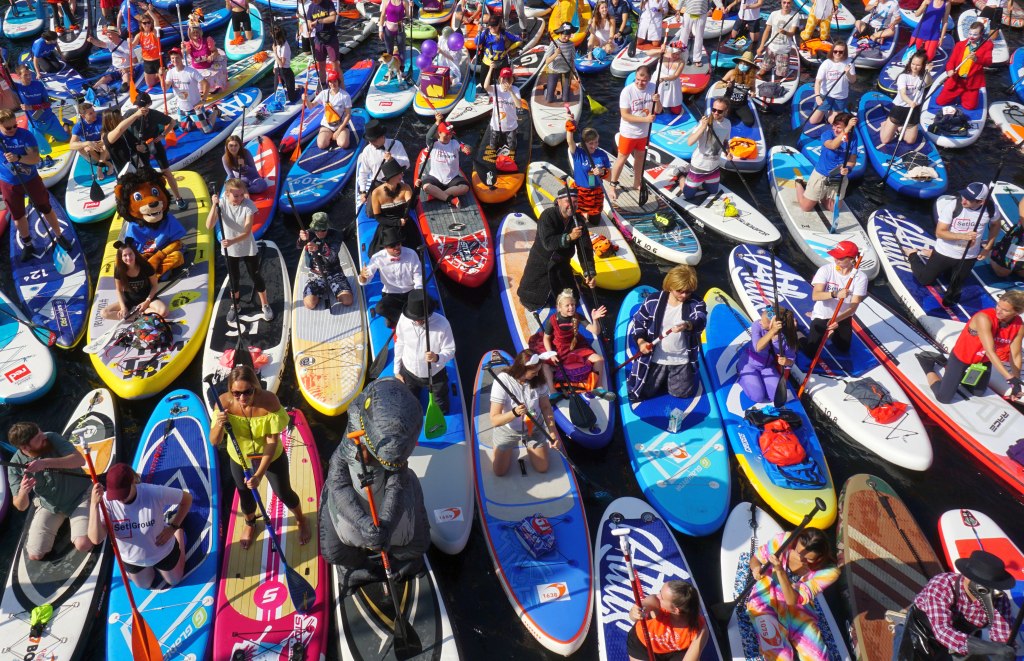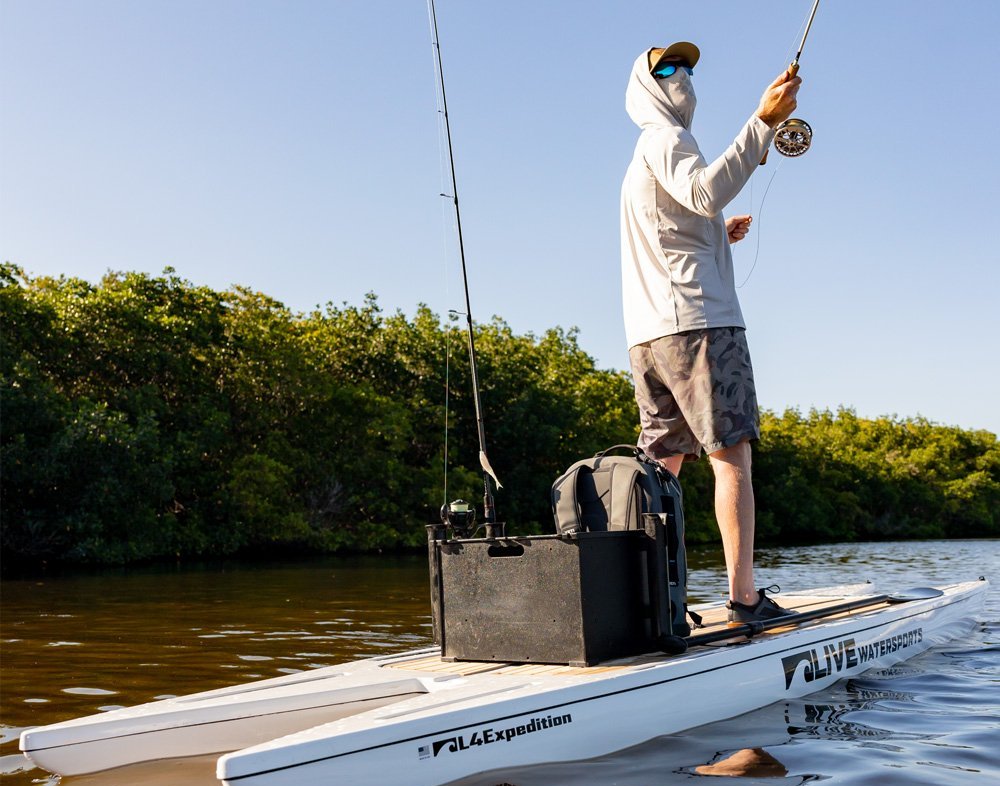Think of buying a stand up paddle board? Below we break down all aspects of SUP costs so you've got a clear idea of how much you can expect to spend.

In a hurry? Our pick for the best yoga SUP is Sea Gods Infinite Mantra.
I’ve been a paddleboarder for a few years now. Most of my summers I spend out on the water—not just on the weekends, but pretty much any afternoon I can get away. There are few more wonderful ways to relax at the end of a long work day than drifting along on a paddle surrounded by water, nature, and clear summer skies.
I’ve also been a Yoga practitioner for 10+ years, using it to stretch before/after workouts, limber up for my kickboxing, and clearing out my head after a busy day.
It made perfect sense, then, to combine the two.
The first time I tried SUP Yoga, however, I learned quickly why the “standard” recreational paddle board just wouldn’t work for Yoga.
My compact, sleek paddle board was built for speed, but has far from enough stability to keep from tipping over while I’m in Tree Pose, Warrior II, or even basic Sun Salutation sequences. I ended up falling into the water half a dozen times because the paddleboard just wasn’t up to supporting my weight and maintaining my balance.
That’s when I knew I had to find the right board, one purpose-built for the activity I wanted to do: Yoga on a paddleboard.
I put together this guide so you can find the best boards you can use specifically for paddle board Yoga and enjoy those lovely hours out on the water practicing your asanas.
As an affiliate of Amazon and other retailers, we may earn a small commission when you buy via our links, at no additional cost to you. Thank you!
At a Glance: Best Yoga Paddle Boards
Best Overall: Sea Gods Infinite Mantra
Best Budget Yoga SUP: Roc Inflatable Stand Up
Best for Beginners: Bote Breeze Aero 10′8″
Best Yoga Board for Tall People: Thurso Tranquility
Best for Heavy Paddleboarders: iRocker BLACKFIN MODEL XL
Best Yoga SUP with Full Deck Pad: Glide 02 Lotus Inflatable SUP Yoga Package
Most Durable: Bluefin Aura Fit
Most Versatile: iRocker CRUISER 10’6″
Best for Couples’ Yoga: Gili Sports Manta Ray 15′
Comparison Table: Best Yoga Paddle Boards
| Model | Specs | Where To Buy |
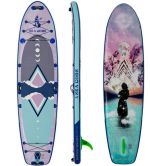 Sea Gods Infinite Mantra | Size: 11’x 34” Weight: 24.5 lbs. Weight Capacity: 350 lbs. | Sea Gods |
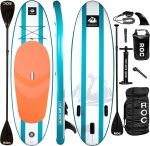 Roc Inflatable Stand Up | Size: 10’x 33” Weight: 18 lbs. Weight Capacity: 350 lbs. | Amazon |
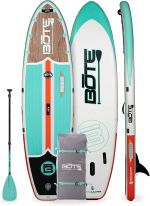 Bote Breeze Aero 10′8″ | Size: 10’ 8”x 33” Weight: 20 lbs. Weight Capacity: 250 lbs. | Amazon |
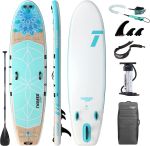 Thurso Tranquility | Size: 10’ 8”x 34” Weight: 29 lbs. Weight Capacity: 350 lbs. | Amazon |
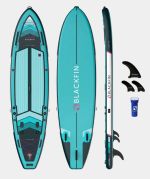 iRocker BLACKFIN MODEL XL | Size: 11’ 6”x 34” Weight: 28 lbs. Weight Capacity: 485 lbs. | iRocker |
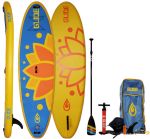 Glide 02 Lotus Inflatable SUP Yoga Package | Size: 10’x 35” Weight: 25 lbs. Weight Capacity: 400 lbs. | Glide |
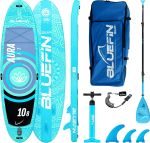 Bluefin Aura Fit | Size: 10’ 8”35” Weight: 29 lbs. Weight Capacity: 260 lbs. | Amazon |
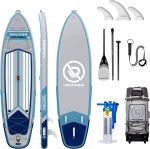 iRocker CRUISER 10’6″ | Size: 10’6”x 33” Weight: 25 lbs. Weight Capacity: 435 lbs. | Amazon |
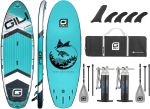 GiliSports Manta Ray 15′ | Size: 15’x 56” Weight: 52 lbs. Weight Capacity: 1150 lbs. | Amazon |
The 9 Best Yoga Paddle Boards
Best Overall: Sea Gods Infinite Mantra
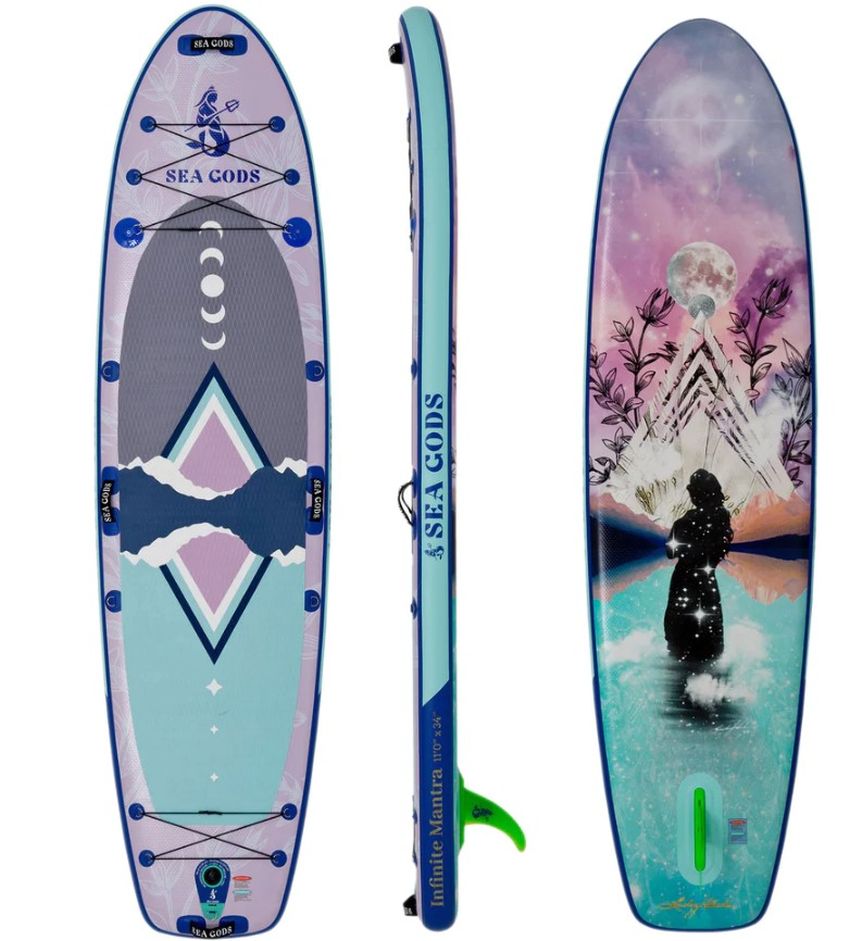
Length: 11’ (335 cm)
Width: 34” (86.4 cm)
Weight: 24.5 lbs. (11.1 kg)
Weight Capacity: 350 lbs. (158.8 kg)
For anyone who wants a paddleboard purpose-built specifically for SUP Yoga, the Sea Gods Infinite Mantra board is one I’ve been using for years now.
In my experience, the board is insanely tough, using military-grade materials in its construction. The addition of heat-molded and reinforced seams and UV protective spray glazing just adds to its durability. The board is designed to withstand very high pressure and will last you for years of use.
Handy features include: side and front/back carry handles, bungee cargo rigging, a full-length deck pad extra-grippy for your Yoga practice, integrated accessory mounts, and extra D-rings if you want to add on a seat.
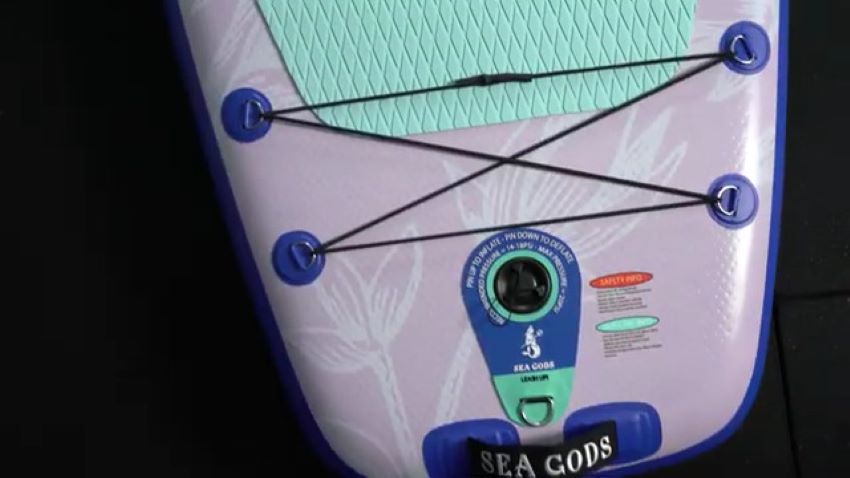
The board is also incredibly stable, thanks to its extra length and slightly above-average width. You’ll find few paddle boards can come to matching it for Yoga SUP performance. Best of all, it’s backed by a limited lifetime warranty!
Best Budget Yoga SUP: Roc Inflatable Stand Up
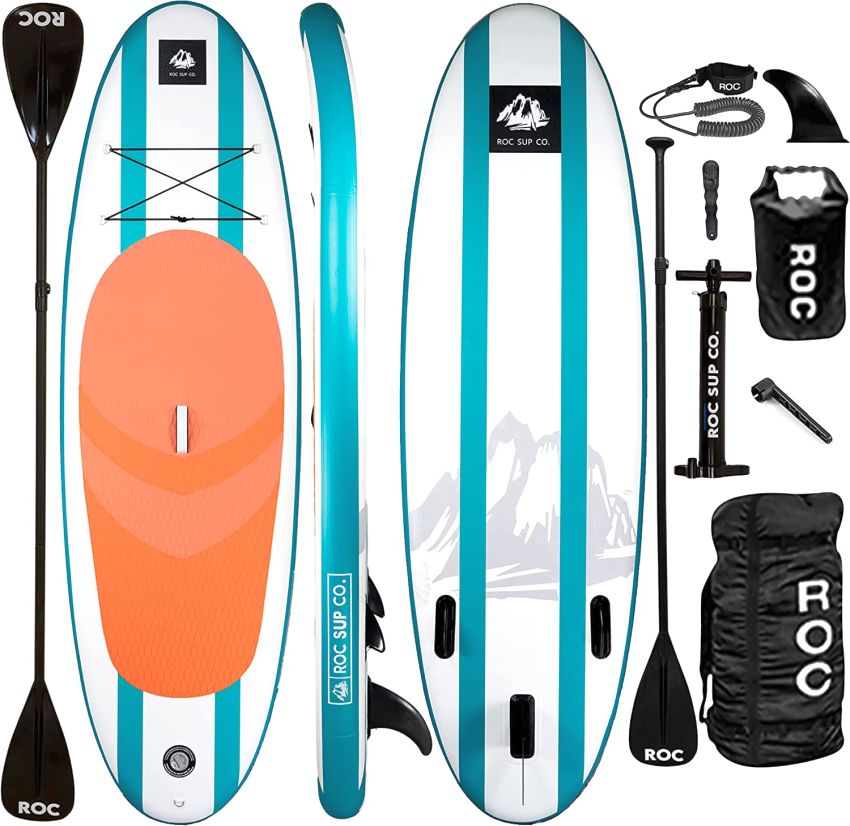
Length: 10’ (304.8 cm)
Width: 33” (83.8 cm)
Weight: 18 lbs. (8.2 kg)
Weight Capacity: 350 lbs. (158.8 kg)
You’ll be hard pressed to find a quality paddleboard that’s more affordable than this one. But despite its low price, it’s not a “cheap” board in terms of quality or performance.
The board is of average length and width (10′ and 33″), so it’s better suited to smaller/lighter Yoga practitioners who are more advanced and stable in their poses. It’s lightweight enough that anyone can haul it to and from the water. Though it doesn’t come with many extra accessories (just a dry bag, leash, fin, paddle, and carrying bag), it’s a great option for anyone looking to buy a paddleboard on a budget.
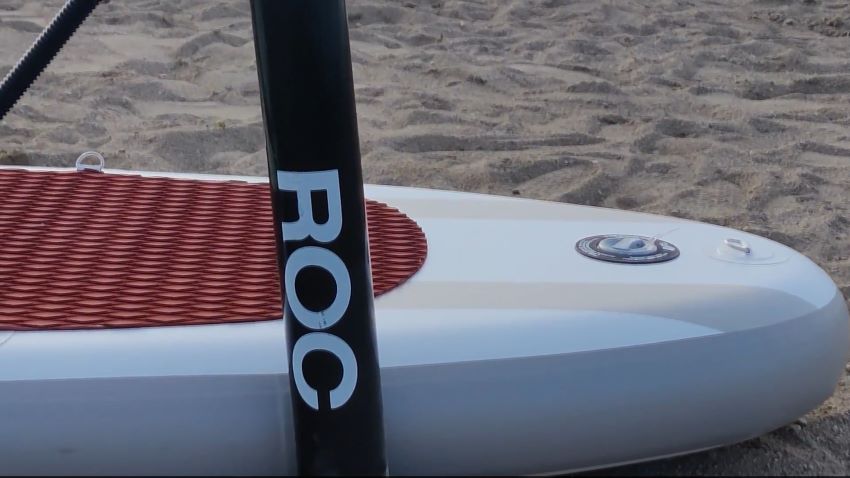
Best for Beginners: Bote Breeze Aero 10′8″
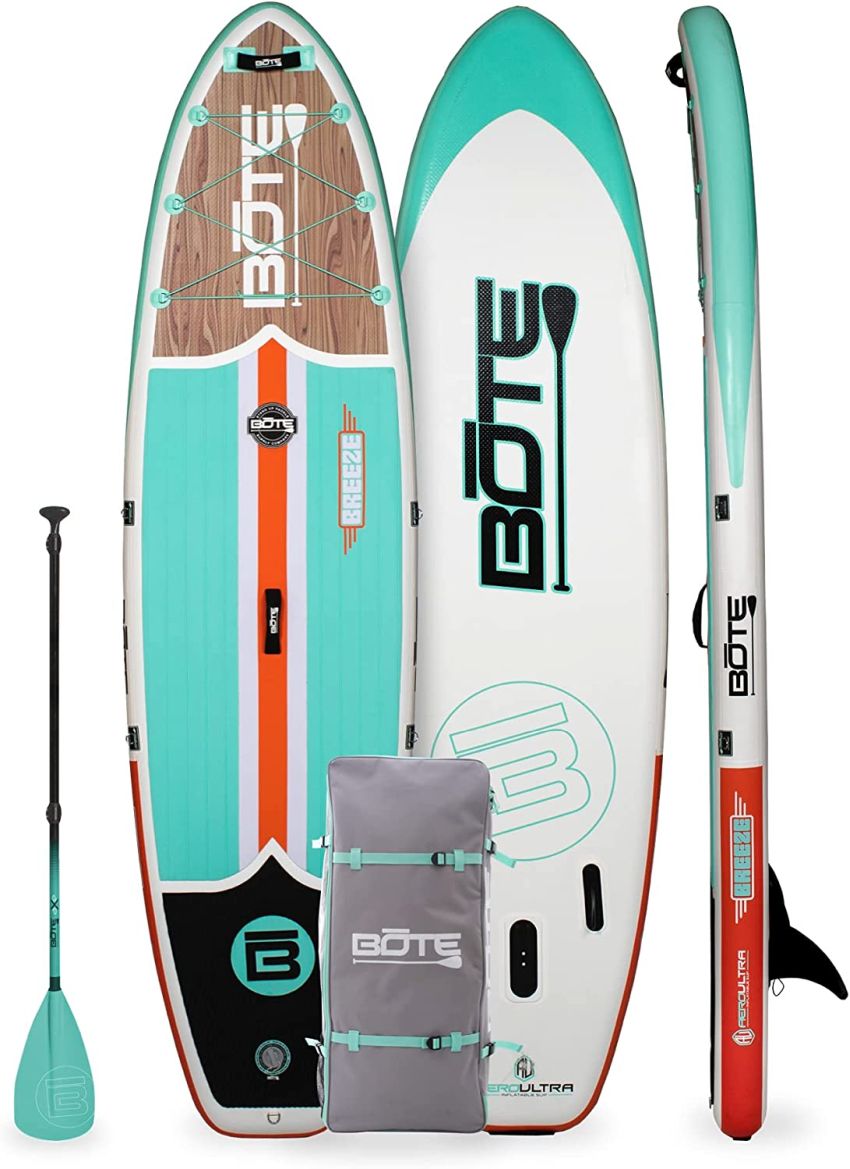
Length: 10’ 8” (330 cm)
Width: 33” (83.8 cm)
Weight: 20 lbs. (9 kg)
Weight Capacity: 250 lbs. (113.4 kg)
If you’re new—to both paddleboarding and SUP Yoga—this is the board for you. The Bote Breeze Aero is incredibly stable, unlikely to tip over or even wobble excessively. We’ve found it a great option to not only find your balance when paddle boarding, but getting the hang of your favorite Yoga balance postures on the water.
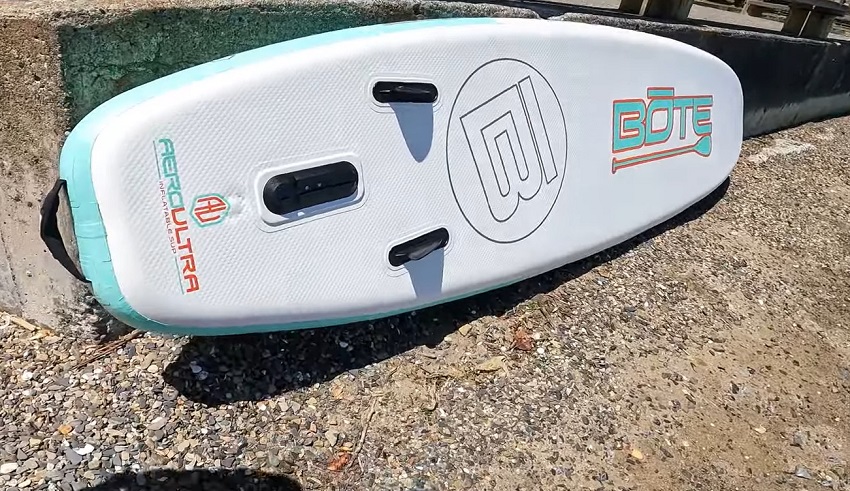
The Breeze AeroUltra technology used in the board’s construction results in one of the lightest yet toughest paddle boards around. It’s surprisingly stiff, thanks to the multi-layered PVC used in its construction. The EVA foam deck pad is comfortable and supportive under your feet, while also providing great traction even when wet.
The side bite fins will ensure you stay always on track, and the removable center fin will both improve handling and provide stability.
Best Yoga Board for Tall People: Thurso Tranquility
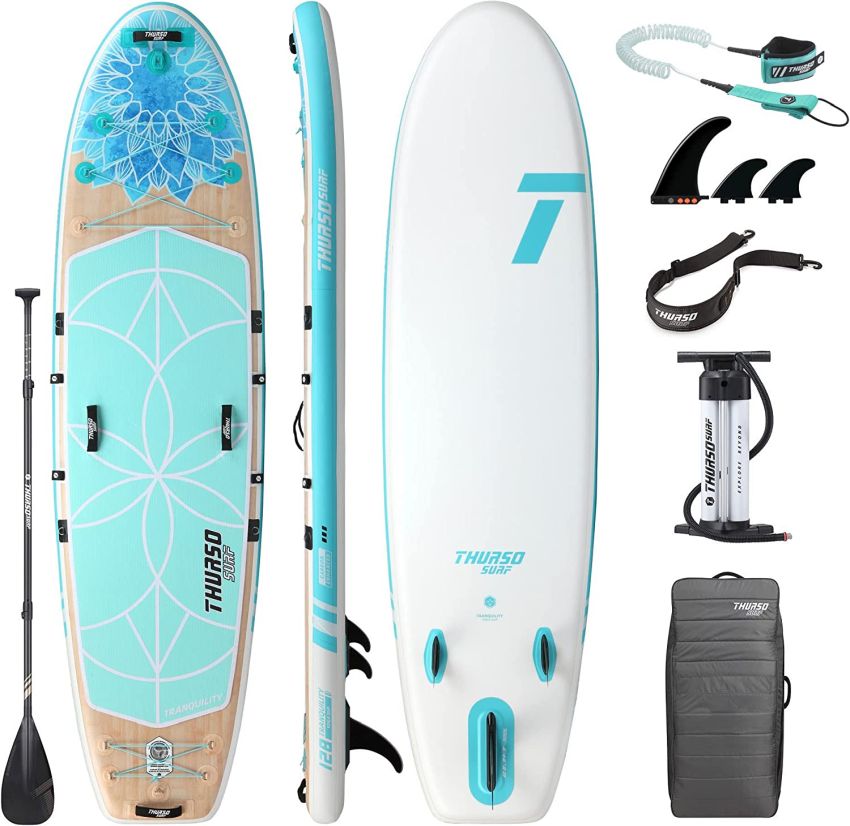
Length: 10’ 8” (330 cm)
Width: 34” (86.4 cm)
Weight: 29 lbs. (13 kg)
Weight Capacity: 350 lbs. (158.8 kg)
For taller practitioners who need extra space to move around, the full deck pad built into this Yoga SUP will be just what you need. The EVA foam offers good cushioning for your feet and is highly responsive for your balance poses. Plus, it provides great traction so you don’t slip or slide around. All three of the provided fins are removable, letting you choose the configuration that suits your preferences best.
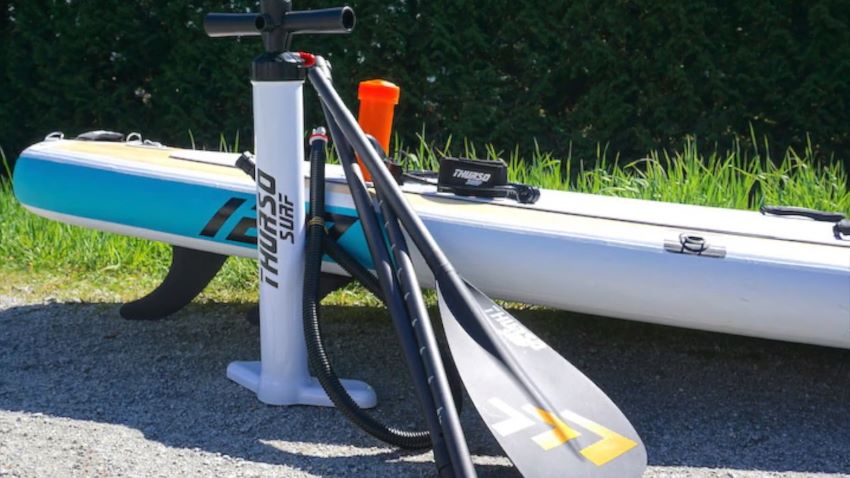
The board itself is quite tough: dual-layered military-grade PVC with extra coating to protect against UV deterioration and reinforcement to ensure sturdy seams. The core is also drop-stitch, making it far more resilient. It feels and performs like a hardboard but is still very portable (if a bit heavy).
Best for Heavy Paddleboarders: iRocker BLACKFIN MODEL XL
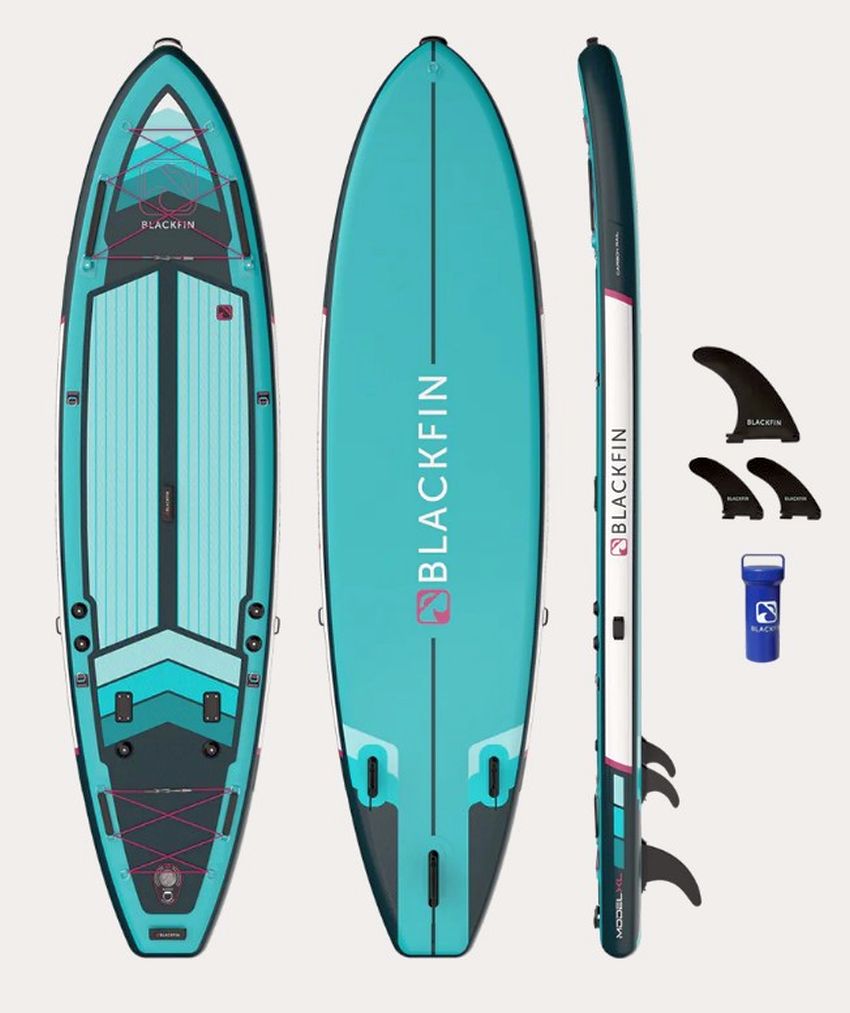
Length: 11’ 6” (350 cm)
Width: 34” (86.4 cm)
Weight: 28 lbs. (12.7 kg)
Weight Capacity: 485 lbs. (220 kg)
If you’re on the heavier side (like me), you’ll need a board with a higher weight capacity. This board’s 485-pound weight cap means you can carry all your needed extra gear on board with plenty to spare.
For those who are having a hard time finding their balance, this board is built specifically for you. The three provides fins add amazing stability to the 34-inch-wide deck, which is made even stiffer and more stable by the addition of a Carbon Rail that runs around the deck’s entire perimeter to reinforce the structure from within.
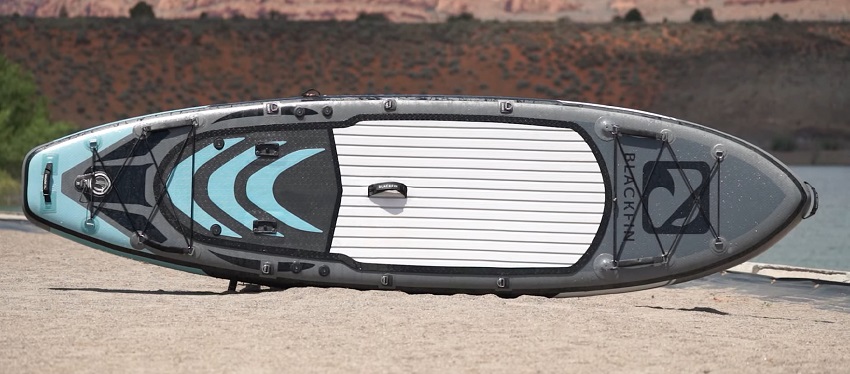
In our tests, the board was maneuverable and agile enough you can take it fishing or paddling around, but it’s also well-suited to Yoga practice out on the water. The 11.5-foot deck has enough room so you can stretch out into those poses or store Yoga blocks, a cooler, water bottle, or even a seat. It’s not just suitable for calm, flat water—you can also take it out on the ocean and down faster-moving rivers and trust it’ll handle itself like a boss.
Best Yoga SUP with Full Deck Pad: Glide 02 Lotus Inflatable SUP Yoga Package
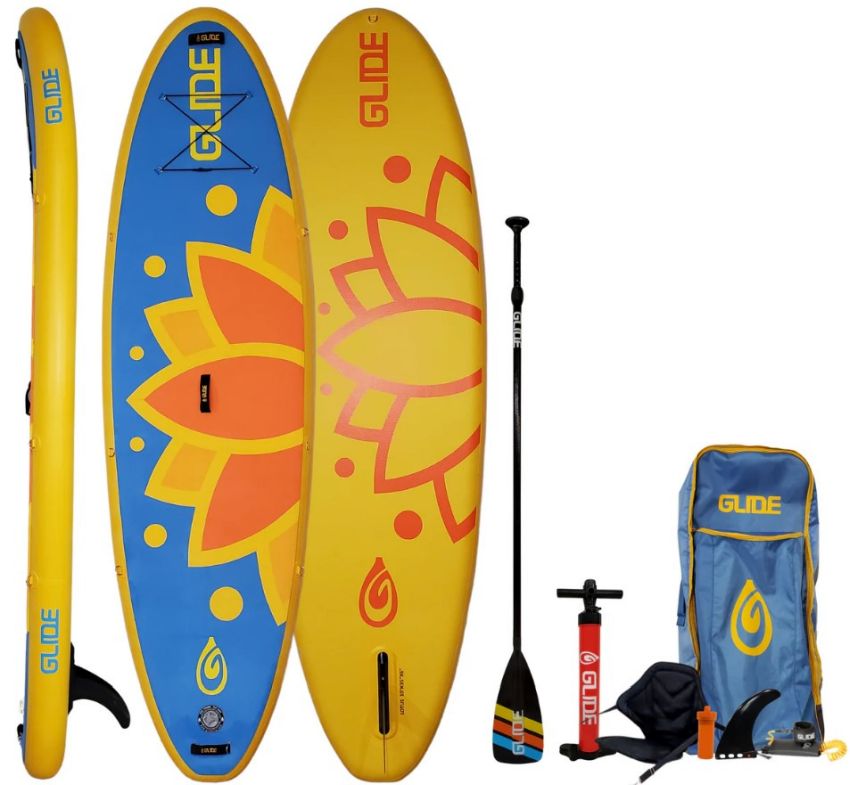
Length: 10’ (304.8 cm)
Width: 35” (88.9 cm)
Weight: 25 lbs. (11.3 kg)
Weight Capacity: 400 lbs. (181.4 kg)
Though it’s not as long as some of the other boards on our list, this board is wider than most (at 35 inches) and thus will be very stable for Yoga. It also features a full-length deck pad so you can move around the entire surface and remain comfortable and supported. The ultra-dense cushioning will help to keep you stable in all your balance poses and cushion your joints when kneeling or on your hands. The only downside is that it may become a bit slippery when wet.
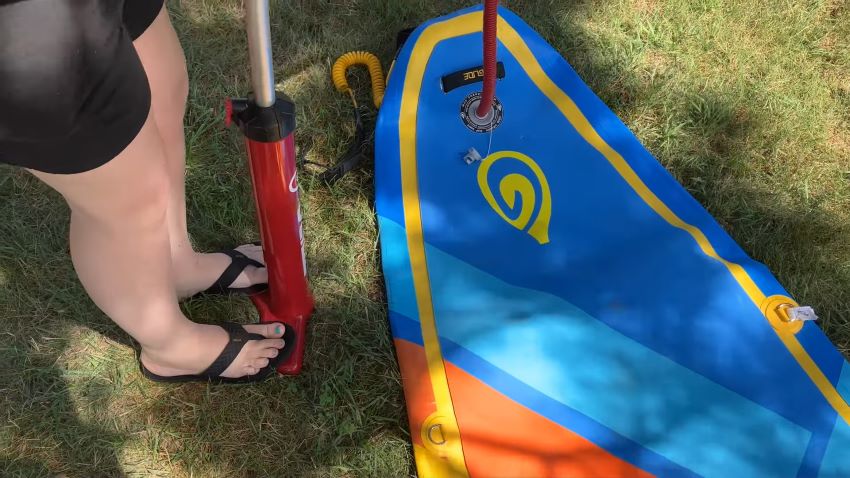
The board is built tough, too, with multiple layers of military-grade PVC, high-pressure heat-pressed seams, and ultra-reinforced drop-stitch construction. The board has a 1300-denier thickness rating, meaning it’s sturdy enough to shrug off impacts, heavy use, and abrasion.
Most Durable: Bluefin Aura Fit
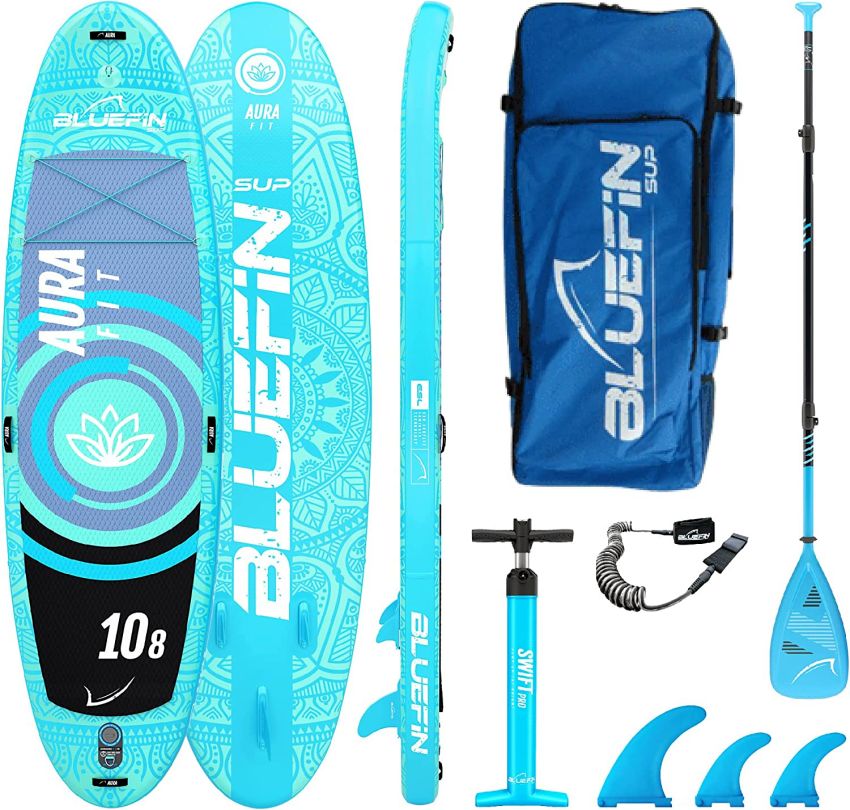
Length: 10’ 8” (330 cm)
Width: 35” (88.9 cm)
Weight: 29 lbs. (13.2 kg)
Weight Capacity: 260 lbs. (118 kg)
This board, like so many others on our list, uses military-grade PVC in its construction. However, it takes it a step farther by using a high-pressure laminated finish, super reinforced composite drop stitch for the core, and thermosealing to ensure the deck pad never unglues or cracks. The result: a board that should last a long, long time even with daily use.
The extra-large deck platform is ideal for Yoga practitioners, giving you more space to move around and switch between the kneeling, standing, and plank poses. Thanks to the kickpad, you’ve got a bit of extra grip to push off against when paddling as well as holding balance poses.
The board includes both bungee cord rigging for storage and an integrated nose action mount so you can film your Yoga sessions as well as your daily paddling outing on the water.
Most Versatile: iRocker CRUISER 10’6″
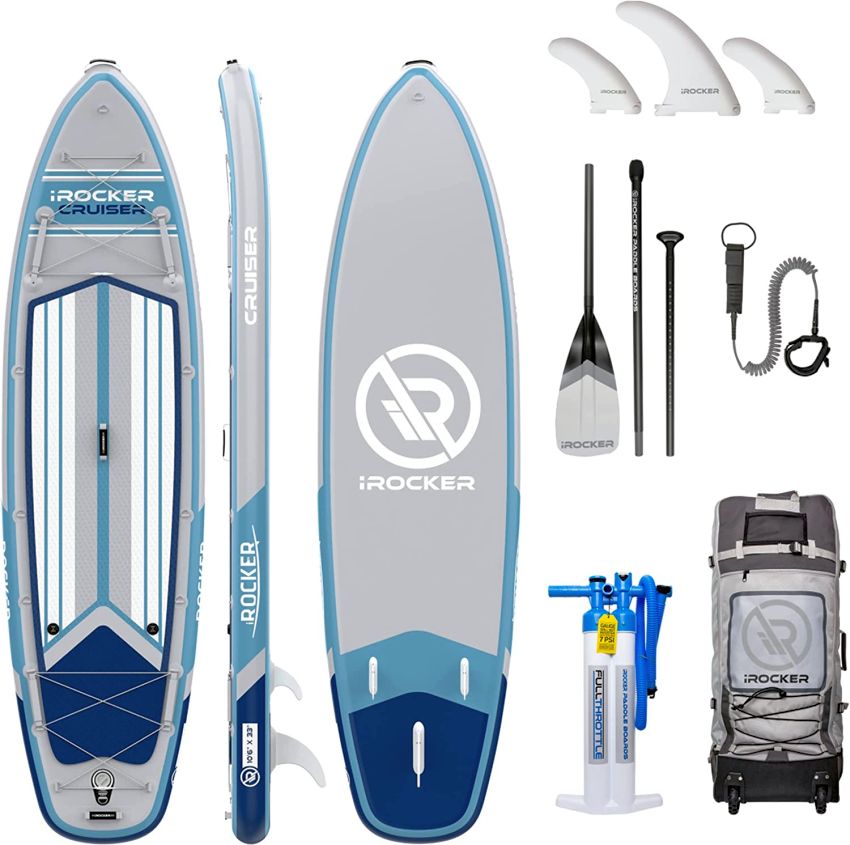
Length: 10’6” (320 cm)
Width: 33” (83.82 cm)
Weight: 25 lbs. (11.3 kg)
Weight Capacity: 435 lbs. (197.3 kg)
This paddleboard is designed more for recreational use, but it’s suitable for smaller, lighter Yogis. It’s an excellent board for paddling swiftly out into the middle of a lake, doing your Yoga, and enjoying the rest of your day zipping around the water.
The board is sized for those under 5’8”, so taller users will want to consider another option. However, its 435-pound weight limit is ideal for heavier paddlers or anyone who wants to carry a lot of gear (Yoga blocks, a drinks cooler, etc.).
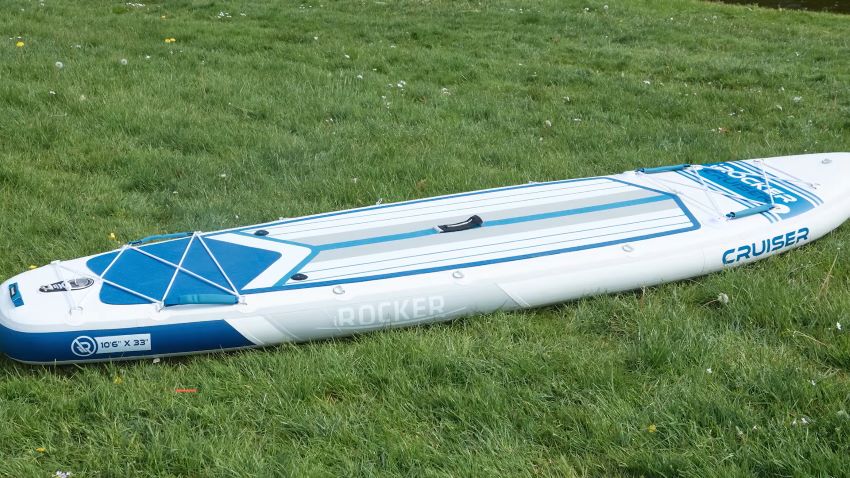
Like all iRocker boards, it’s built using triple-layered military-grade PVC laminate joined using drop-stitch technology that adds durability (as well as a bit of extra weight). Not only is it incredibly stable, but it can be used for tandem paddling or taking a pet or child out on the water with you for a day under the sun.
Best for Couples’ Yoga: Gili Sports Manta Ray 15′
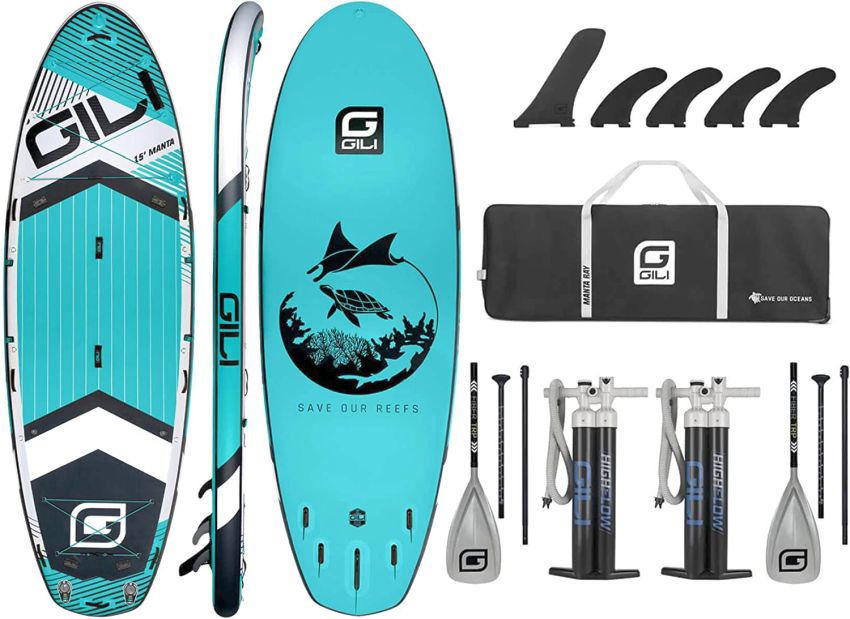
Length: 15’ (457.2 cm)
Width: 56” (142.24 cm)
Weight: 52 lbs. (23.6 kg)
Weight Capacity: 1150 lbs. (522 kg)
If you’re into couples’ Yoga, this is the Yoga SUP you’ll want to take out on the water. At 15 feet in length, it’s long enough to accommodate two people for Yoga practice or just enjoying a day of floating in the sun.
The weight capacity is also insanely high (a whopping 1150 lbs.), though the trade-off is a board that’s also on the heavier side (at 52 lbs.).
Features of this board include a spacious deck pad, multiple action and Scotty mounts, oversized bungee cord storage, two pumps, two paddles, multiple grab handles, and a rolling carry bag perfect for hauling it to and from your car.
Once your Yoga workout is done, this board is perfect for a “party barge” and can accommodate up to 5 (lighter) passengers at once.
Factors to Consider When Buying Paddle Boards for Yoga
Hardshell vs. Inflatable
The debate of hardshell vs. inflatable isn’t just about durability. The materials used will definitely affect its ability to endure hard use for years, but portability and buoyancy are also crucial elements that come into play with Yoga paddleboards.
Let me explain…

The ability to deflate a paddleboard and pack it into a backpack-sized carrying container makes it much easier to take your board anywhere. You can throw it in the trunk of your car, even take it on the train or bus. The portability of inflatable SUPs is absolutely game-changing.
And what do you inflate those SUPs with? Air, of course, which is incredibly buoyant. Air enclosed within the SUP will make an inflatable paddleboard far more likely to float and remain upright than a board that contains a solid core. For this reason, most Yoga boards are inflatables.
Now, I will say that hard-shell boards are definitely more durable. Materials like fiberglass, carbon fiber, and even thermoplastic can take a real beating. However, given that you’re going to be using the paddleboard for Yoga, not some active whitewater or long-distance touring adventures, it’s safe to say durability isn’t the most important factor to consider.
At the end of the day, the added buoyancy and portability of an inflatable typically wins out over hard-shell durability for Yoga SUPs. The fact that inflatable boards tend to be cheaper is just the cherry on top!
Stability
It’s already quite challenging to remain stable and balanced while in those complex Yoga poses (I’m still struggling to master Crane Pose and Royal Dancer pose even after years of practice). Adding the instability of a floating platform just makes things all the harder!
That’s why the most important factor to look for in a Yoga board is stability.
Typically, Yoga boards feature a flat planing hull that floats on top of the water (compared to a displacement hull used by racing, touring, and surfing SUPs). This hull shape, together with the Yoga board’s size (see the next section) provided maximum primary stability—a.k.a. stability on flat, calm water.
(Note: With Yoga boards, you don’t need to worry too much about secondary stability, or stability on choppy water. You’ll largely be practicing your Yoga on calm lakes and ocean inlets where you get few waves and only very light currents.)

Size
Size plays a crucial role in the stability of your board.
Think about your Yoga SUP like a floating platform: the larger it is, the less likely it is to tip over.
Yoga paddle boards tend to be:
- Longer (usually 11+ feet, though some can be 13 to 15 feet long)
- Wider (usually 36+ inches, with some as wide as 42 inches)
- Thicker (usually 4 to 6 inches)
The longer, wider, and thicker boards not only provide you with a larger and more stable platform, but also have more volume in order to increase your buoyancy.
There are some Yoga SUPs that are sized comparable to recreational boards, but you’ll find most of the Yoga-specific paddle boards on our list are larger than “average”.
Fair Warning: Yoga boards will be less maneuverable and more sluggish than other types of paddleboards. You’re sacrificing speed and agility in favor of maximum stability.
Weight Capacity
Weight capacity is determined by the size and buoyancy of the Yoga board. Larger, wider, and thicker inflatable boards have a much higher weight capacity than a smaller, narrower, thinner hard-shell board. That’s because not only is the platform larger, but there is more volume to add buoyancy.
Weight capacity matters for paddlers who are a bit on the heavier side (such as myself, at 250 lbs.). The higher the weight capacity, the more easily the board will bear up under your weight—and therefore remain stable and afloat as you move through your Yoga poses.
Deck Padding
Deck padding is usually added to SUPs to provide you a comfortable surface to kneel or stand on. It’s a “nice to have” for most boards.
For a Yoga SUP, however, it’s a “must have”. A good deck pad will act like a Yoga mat, providing you a comfortable, supportive, and grippy surface for your poses.
Note: You can bring your own Yoga mat aboard a paddleboard. However, Yoga mats may grow slippery when wet, whereas SUP deck pads are designed to be grippy even when wet.
Fins
Fins are a surprisingly crucial component of any SUP.
Most people think of fins as being important largely for tracking and handling. That is true: fins will help your SUP to move straighter.
However, fins are also crucial for stability. Think of them like a miniature paddle thrusting straight down into the water, creating water resistance (drag) every time the board wobbles side to side.
Without a fin (or three), your Yoga SUP will be far less stable and more prone to tipping over. You’ll be glad to know all of the Yoga paddle boards on our list do include at least one fin to maximize stability.

Features
Most SUPs may come with (or can be expanded with) a number of features, such as:
- D-rings to clip on accessories
- Action mounts for cup holders, fishing rod holders, cell phone holders, and more
- Bungee cord rigging on the deck to provide you with secure storage
Yoga SUPs tend to be far less feature-rich than some others (say, for example, fishing SUPs (HYPERLINK FISHING SUP ARTICLE)) because you don’t really need much to enjoy a day of floating and posing.
Still, some of the features mentioned above will come in handy and make your time out on the water more enjoyable.
Accessories
Some accessories are necessary for your safety (i.e. a leash that tethers you to the board and keeps it from floating away), others are critical for maneuvering (i.e. the paddle and fins), and some are just handy to have (i.e. paddle keeper so you have someplace to safely store your paddle while you’re focused on your Yoga, or an electric pump to make inflating the board easier).
It’s always worth looking at what accessories are included in the package to make sure you’re getting the best bang for your buck.
Price + Warranty
I’m the kind of guy who wants to find the best product at the lowest price possible. I’ll consider any paddleboard that strikes just the right balance between affordability and reliability. Most of the options on our list above are included because they represent great value for the money.
Price is just the starting factor to consider. It’s always worth diving a bit deeper and reading reviews, talking to other paddle boarders, even testing a few out for yourself. Anything to make sure you find the paddle boards that are good quality and built to last. Those are the ones you want to buy, even if that means paying a little more than the real “bargain” models.
Looking at the warranty will also tell you a great deal about the caliber of the paddle board.
- Most “cheap” boards will come with a 6-month or 1-year warranty.
- Mid-tier boards will have a 2-5 year warranty.
- Top-quality boards will usually be backed by a 5 to 10-year warranty.
The longer the warranty, the more it’s clear the manufacturer stands by the quality of their product. And that’s a product I want to use!
Tips for Yoga Paddleboarding
● Don’t be intimidated by the water. Unless the water is very cold, it can actually be quite refreshing to fall off your paddle board. It’s also very easy to climb back aboard and resume your pose.
● Choose a calm, quiet spot. You want minimal waves and currents, nothing that could throw off your balance or distract from your concentration.
● Keep your center of gravity low. The lower your center of gravity, the easier it will be to maintain your balance. Standing poses will always be tougher than kneeling, crouching, or lying-down poses.
● Fix your eyes on the horizon—or, if you’re near land, some other unmoving focal point. It will be easier to maintain your balance with something solid and tangible to focus on.
● Dress for the water and weather. If the water is cold, wear multiple layers or a wet suit. If the day is very hot and bright, make sure to wear long sleeves and sunscreen to avoid sunburn.
● Breathe and stay calm. It may feel tricky at first, but with practice, you’ll eventually master the balance on your paddleboard.
● Stick with simple poses. Only move on to the harder ones once you know you’ve got the balance down right.
● Size up if necessary. If the board isn’t feeling stable enough, you can always get a larger-sized, more stable board for your Yoga practice.
Best Yoga SUPs FAQs
A Yoga SUP will typically be longer, wider, and thicker than a “regular” recreational SUP. Yoga SUPs sacrifice maneuverability and speed in the name of greater stability.
You absolutely can do Yoga on an inflatable SUP! In fact, the air used to inflate the SUP increases the board’s buoyancy, making it a better choice for Yoga than hard-shell boards.
You don’t need an anchor for SUP Yoga, but it’s certainly a handy accessory to have. An anchor can keep you tethered to one location and keep you from drifting into nearby paddleboarders, docked boats, the beach/shore, or being pulled out to sea.
First, you need a good Yoga paddleboard, such as one of the ones we share on our list. Once you’ve got the board, all you need to do is take it out on the water, master its balance, and get started with your favorite Yoga poses. It’s as simple as that!



